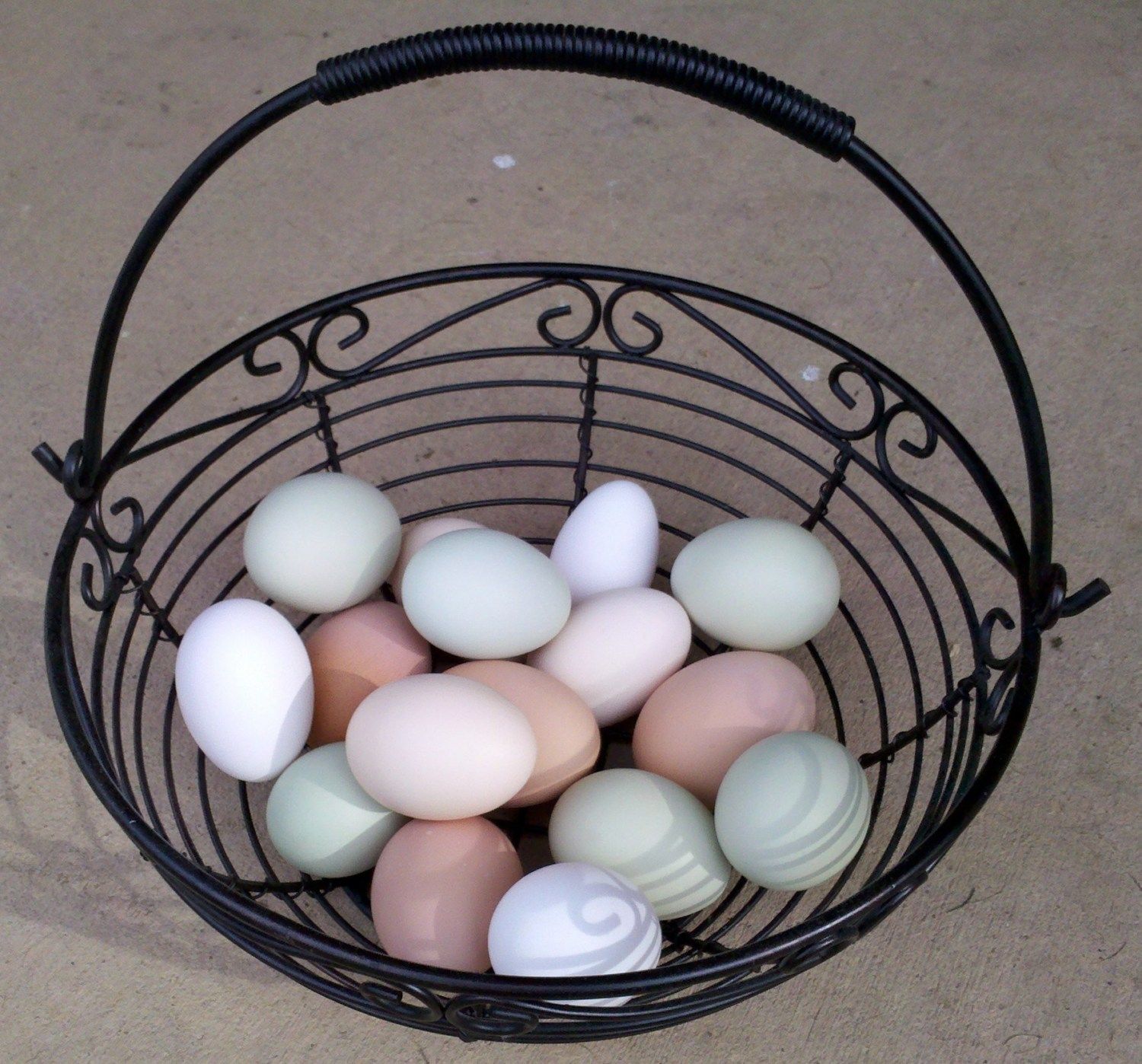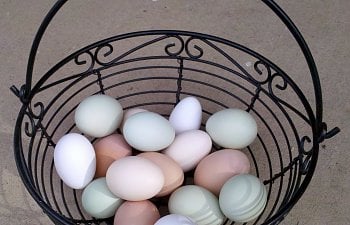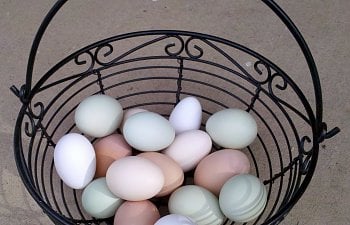So You Want a Colorful Egg Basket!
I’m very partial to a colorful egg basket. No blah all white or all brown eggs for me! The more colors, the better. Like many people, I grew up thinking white eggs were what you bought at the grocery store, and brown eggs were what you got from a farm. I remember the first time I saw blue eggs. We had gone to our local farmers’ market, and there was a farm family selling eggs. The eggs were beautiful – all browns and blues. After that, and until I got chickens of my own, I went to the farmers' market each weekend and bought my eggs from that farmer. I knew that colorful eggs were what I wanted from my own chickens. As I learned more about chickens, I learned that not only were there white, brown and blue eggs, but there were varying shades and combinations of each color.
Before selecting chickens for a laying flock, it is important to know two basic facts about egg colors:
- The color of the egg shell has no bearing on the taste or nutritional composition of the egg. Once you crack open the shell, all eggs are essentially the same. Having a variety of egg shell colors is purely a visually aesthetic endeavor.
- The color of each hen’s eggs will remain the same throughout the hen’s life. The shade of the color will usually be darker at the beginning of each egg-laying cycle and lighter at the end, but the basic color doesn’t change.
When it comes to eggs, there are three main colors: white, brown, blue. The other colors are some combination of those three colors.

When I bought my first flock of 7 chickens, I got 4 Easter Eggers (blue/green eggs), a New Hampshire (brown egg), a Jersey Giant (brown egg), and an Ancona (white egg). Three of my Easter Eggers laid blue/green eggs, but one ended up laying a cream colored egg – which was disappointing at first until I realized it provided a new color for my egg basket. I'm still missing a dark chocolate brown egg, but I should start getting those any day now.
Here are some guidelines for building a flock that will lay a variety of egg colors. For the purposes of this article, we are looking only at LF (Large Fowl) breeds that are recognized as good-to-excellent layers. However, if there is a breed you particularly like, it might be worth it to you to get fewer eggs in order to have that breed.
White Eggs
Leghorns are the standard for proficient layers of white eggs. There are many varieties of leghorns. The long-favored variety is the white leghorn, but there are also brown leghorns, exchequer leghorns (white with black spots), black leghorns, and even mille fleur (multi-colored) leghorns – and others. While there are other breeds that lay white eggs, you’ll get the most eggs from leghorns. Leghorns are smaller chickens and are known for laying more eggs while eating less (feed to egg ratio).
Light Brown/Brown Eggs
Light brown/brown can vary from a pale almost-white cream color to a pinkish color to a rich caramel brown. If you’re looking for lots and lots of brown eggs, you can’t go wrong with a sex-link. Sex-links are cross-bred chickens that can be sexed at hatch by their color. The extra vigor they have as hybrids usually makes them extremely good egg-layers. There are many varieties of sex-links, and often hatcheries come up with their own name for a variety. One popular variety is a Black Star – which is a cross between a Rhode Island Red or New Hampshire rooster and a Barred Rock hen.
Other excellent light-brown/brown layers are Rhode Island Reds, New Hampshires, Black Australorps, and Barred Rocks.
Dark Brown Eggs
Marans lay some of the darkest brown eggs – with the Black Copper Marans laying the darkest. There are other varieties of Marans as well - Cuckoo Marans, Blue Copper Marans, White Marans, Wheaten Marans, to name a few.
Another popular dark egg layer is the Welsummer. Welsummer eggs won’t be as dark as a Marans, but they often have speckles which makes them appealing for variety.
Blue/Green Eggs – Easter Eggers are the most common of the blue/green egg layers since they’re “mutts” and not recognized as a distinct breed. Despite being mutts, there are some beautiful Easter Eggers, and I particularly enjoy them. They’re usually easy-going, and I love their beards and the muffs on either side of their faces. Easter Eggers are generally good layers, but it is a gamble about what color egg you’ll get. Most lay greenish eggs – but you can also get blue, blue-green, olive or light brown – really just about any color is possible. Still, the odds are that you'll get blue/green eggs from an Easter Egger..
Other blue egg layers are Araucanas, Ameraucanas and Cream Legbars. Isbars lay a mossy colored green egg – sometimes with speckles. Salmon Favorelles lay a light brown egg that sometimes looks pink. Each of these breeds are fair to good layers, although not quite as prolific as a Leghorn or sex-link.
Olive-Eggers are a mix between a blue/green layer and a dark brown layer. For example, breeding an Ameraucana with a Black Copper Marans. Depending on which breeds were used, an Olive-Egger could also be a great layer and offer yet another color for your egg basket.
How to use this information
Here is a suggested plan of action for building your flock for maximum variety of egg shell colors:
- Decide how many chickens you want for your flock. On average, you can count on 3 to 5 eggs per week from each chicken. This will vary, of course, depending on the breeds, the time of year and a host of other factors.
- Decide which color eggs you want and the ratio of colors. For example, do you want mostly blue/green eggs with a few brown and an occasional white to help show off the variety of colors?
- Research each breed and determine which ones appeal to you the most. Each person has his/her own preferences. Do a Google or BYC search on each breed. Make sure the typical temperament of each breed will fit your needs and situation. Most breeds have a thread on the BYC Forum. Join that forum and ask the members questions to help you make your decision.
- Locate a resource for each breed you want. It could be a hatchery, a local breeder, or you could obtain hatching eggs and incubate them at home. You can almost always find resources through the BYC Buy-Sell-Trade forum. Sometimes you can find good resources online through sites such as Craigslist.
Once you have your flock established, be sure to show off photos of your colorful eggs! Good luck!



